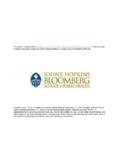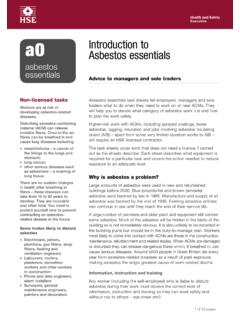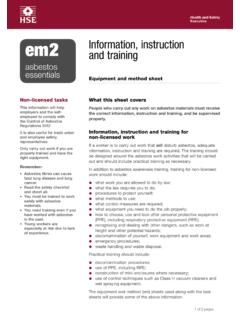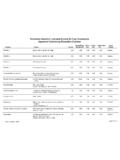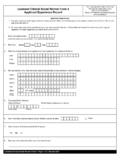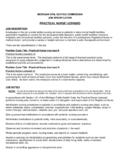Transcription of This work is licensed under a Creative Commons Attribution ...
1 This work is licensed under a Creative Commons Attribution -NonCommercial-ShareAlikeLice nse. Your use of this material constitutes acceptance of that license and the conditions of use of materials on this 2006, The Johns Hopkins University, Patrick Breysse, and Peter S. J. Lees. All rights reserved. Use of these materials permitted only in accordance with license rightsgranted. Materials provided AS IS ; no representations or warranties provided. User assumes all responsibility for use, and all liability related thereto, and must independently review all materials for accuracy and efficacy. May contain materials owned by others. User is responsible for obtaining permissions for use from third partiesas of VentilationPatrick N. Breysse, PhD, CIHP eter Lees, PhD, CIHJ ohns Hopkins UniversitySection AIntroductionOpportunities for Controlsource -transmission -receptor4 Source.
2 Peter LeesPurposes of Industrial Ventilation Control of toxic air contaminants to acceptable levels Control of noxious odors Control of heat and humidity for comfort and health Prevention of fire and explosions5 Types of Industrial Ventilation General ventilation Control of temperature, humidity, and odors Dilution ventilation Maintain control of low toxicity gases and vapors below acceptable levels through dilution of concentrationContinued6 Types of Industrial Ventilation Local exhaust ventilation Capturing and removing contaminants at or near their sources of emission Prevents the transmission of contaminant to worker Given priority in Hierarchy of Controls 7 Section BVentilation Basic PrinciplesVentilation TerminologyContinued9 Ventilation Terminology Capture velocity Air velocity at any point in front of the hood necessary to overcome opposing air currents and to capture the contaminant at that point causing it to flow into the hood Important hood/process design criteria Continued10 Ventilation Terminology Face velocity Air velocity at the hood or slot opening An important design parameter
3 Surrogate marker of performance ( , can be tested)Continued11 Ventilation Terminology Duct velocity Air velocity through the cross-section of the duct Must be sufficient to prevent gravitational settling of particulate contaminants Important design parameter Can be measured12 Basic Ventilation EquationQ = A*V Where: Q = air flow rate (ft3/min) A = cross-sectional area of duct or opening (ft2) V = average air velocity (ft/min) Also referred to as continuity equationContinued13 Basic Ventilation EquationQ = A*V Example If fan is unchanged and number of hoods is doubled, then the resulting hood face velocities will be 1/2 original velocity (possibly reducing air velocity to less-than-needed capture velocity)14 Section CVentilation Design and TestingHood Proximityand Exhaust Volume To maintain desired capture velocity, locate hood as close to source as possible Air volume requirement increases as square of the distance Reduces required make-up air and associated costsContinued16 Hood Proximityand Exhaust Volume17 Use of Enclosures Using techniques such as enclosures.
4 Control capabilities are maximized Air volumes requirements are drastically minimized Reduces required make-up air and associated costsContinued18 Use of Enclosures19 Direction of Air Movement Direction of air movement should carry air contaminants away from breathing zone Results in reduced worker exposure Results in better hood capture performanceContinued20 Direction of Air MovementContinued21 Direction of Air Movement22 Design Velocities All ventilation systems are designed to operate most effectively within a given air-flow range Usually measured by hood face velocity Laboratory hood = 75 100 ft/min Operation at other than design velocities can often have unintended (bad) consequencesContinued23 Principles of Supply Air Design Supply air volume = exhaust air volume (balanced) Avoid interference with exhaust hoods (currents and eddies may compromise exhaust systems) Air enter at living zoneContinued24 Principles of Supply Air Design Supply air must be conditioned (temperature and humidity) Air entry points located away from source of contaminants to eliminate air currents which could interfere with exhaust25 Testing Ventilation Systems Ensure it meets design criteria Comply with regulatory standards Determine system balance Determine if maintenance or repair required Determine whether existing system is capable of handling additional hoods26










